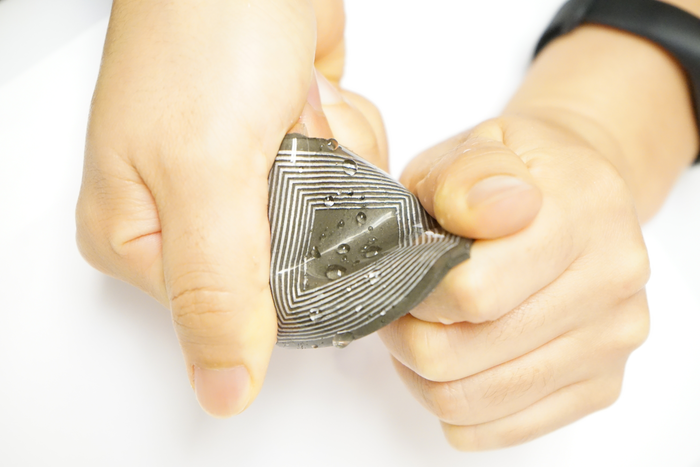A group of bioengineers from the Samueli School of Engineering, University of California-Los Angeles have developed a novel soft and flexible self-powered bioelectric device.
 UCLA-designed self-powered, stretchable, waterproof magnetoelastic generator for bioelectronics. Image Credit: Jun Chen/UCLA.
UCLA-designed self-powered, stretchable, waterproof magnetoelastic generator for bioelectronics. Image Credit: Jun Chen/UCLA.
The technology aims to convert human body motions, like moving an elbow or subtle motions like pulse on the wrist, into electricity that could be used to charge wearable and implantable diagnostic sensors.
The researchers found that the magnetoelastic effect, which is the variation in the number of materials that are magnetized when minuscule magnets are constantly pushed together and pulled apart by mechanical pressure, exists in a soft and flexible system, not specifically a rigid one.
To validate their theory, the team employed microscopic magnets dispersed in a paper-thin silicone matrix to produce a magnetic field that alters in strength as the matrix undulated. Electricity is generated as there is a shift in the strength of the magnetic field.
The comprehensive discovery, the theoretical model underlying the breakthrough and the demonstration were presented in a study published in the journal Nature Materials, also highlighted in the journal Nature.
Our finding opens up a new avenue for practical energy, sensing and therapeutic technologies that are human-body-centric and can be connected to the Internet of Things. What makes this technology unique is that it allows people to stretch and move with comfort when the device is pressed against human skin, and because it relies on magnetism rather than electricity, humidity and our own sweat do not compromise its effectiveness.
Jun Chen, Study Lead and Assistant Professor of Bioengineering, Samueli School of Engineering, University of California-Los Angeles
The team led by Chen developed a small, flexible magnetoelastic generator — similar to the size of a U.S. quarter — from platinum-catalyzed silicone polymer matrix and neodymium-iron-boron nanomagnets. Furthermore, it was mounted on a subject’s elbow using a soft, stretchy silicone band.
The researchers observed a four times stronger magnetoelastic effect than similarly sized setups with rigid metal alloys. Finally, the device produced an electrical current of 4.27 mA/cm2, which when compared to the next best technology has 10,000 times better performance.
The magnetoelastic generator is sensitive enough to convert human pulse waves into electrical signals and operates as a self-powered, waterproof heart-rate monitor. It is also possible to employ the generated electricity to sustainably power other wearable devices, such as sweat sensors or a thermometer.
Existing works aim to make wearable generators that harvest energy from human body movements to power sensors and other devices, but the lack of practical application aspects poses a challenge for the progress. For example, the lack of bending in rigid metal alloys with a magnetoelastic effect makes it inefficient to compress against the skin and generate meaningful levels of power for viable applications.
Other devices that depend on static electricity do not generate sufficient energy. The system performance can also decline in humid conditions, or when the skin sweats. Attempts to encapsulate the devices to keep water out resulted in a decrease in the effectiveness of the device. However, the novel wearable magnetoelastic generators from UCLA performed better at tests even after being soaked in artificial perspiration for a week.
The UCLA Technology Development Group has filed for the device patent.
Journal Reference:
Zhou, Y., et al. (2021) Giant magnetoelastic effect in soft systems for bioelectronics. Nature Materials. doi.org/10.1038/s41563-021-01093-1.